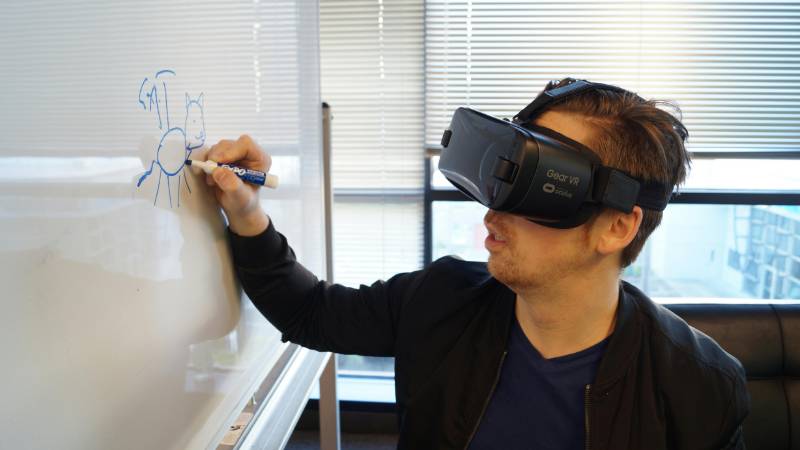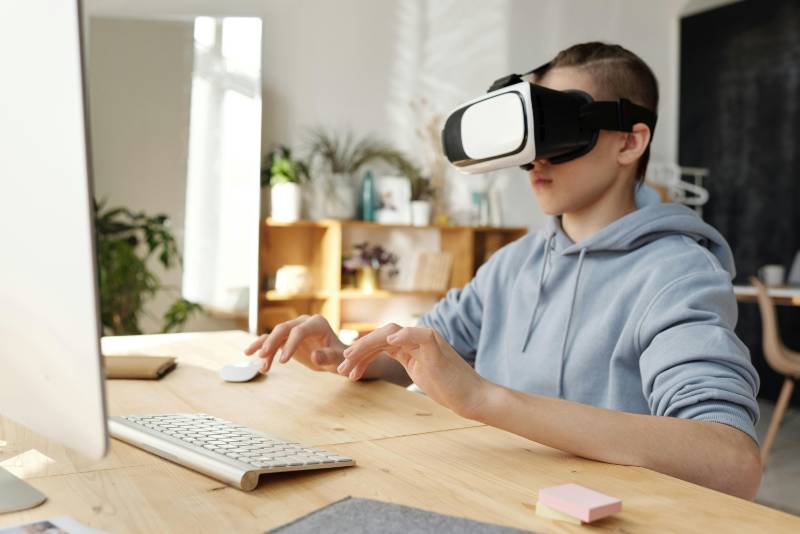
The Rise of Virtual Reality Classrooms in Education
10 min read
13 Oct 2025
Introduction
Virtual Reality (VR) is rapidly transforming the education sector by creating immersive learning environments that extend beyond the limitations of traditional classrooms. By enabling students to experience historical events, scientific phenomena, and complex concepts firsthand, VR classrooms significantly enhance engagement, understanding, and retention. VR not only makes learning interactive and fun but also prepares students for a future where digital literacy and experiential learning are essential skills.
How VR is Shaping Modern Education
VR technology allows students to enter three-dimensional learning environments where they can interact with objects, conduct experiments, and collaborate with peers in real-time. Unlike traditional methods, VR classrooms offer experiential learning, making abstract concepts tangible and easier to grasp. Virtual environments can be customized to accommodate different learning styles, whether visual, auditory, or kinesthetic, improving educational outcomes for all students.
Benefits of VR Classrooms
- Provides immersive and interactive learning experiences that make abstract concepts concrete
- Enhances engagement and motivation among students, reducing classroom distractions
- Facilitates practical learning in subjects like science, engineering, medicine, and arts
- Encourages collaboration and teamwork through shared VR simulations
- Makes education more accessible for remote or differently-abled learners
- Supports experiential learning that improves knowledge retention and critical thinking
VR in STEM Education
STEM subjects benefit immensely from VR. Students can perform virtual chemistry experiments without the hazards of a real lab, explore human anatomy in three dimensions, and simulate physics experiments. Teachers can demonstrate complex processes visually, allowing students to manipulate variables and see real-time results. VR also inspires innovation and problem-solving skills by giving students the freedom to experiment in a risk-free environment.
VR in History and Geography
History and geography lessons are significantly enhanced by VR. Students can virtually visit ancient civilizations, witness historical events, or explore remote geographical landscapes. This immersion promotes better understanding, empathy, and engagement. Virtual field trips provide an experience close to real-life exploration, making learning more memorable and interactive.
VR in Special Education
VR classrooms provide inclusive learning opportunities for students with disabilities. Customized VR experiences allow learners to engage at their own pace, practice social and cognitive skills, and interact with content in a comfortable environment. For students with sensory or mobility challenges, VR offers a safe, engaging, and highly personalized learning experience.
Challenges of Implementing VR in Education
- High costs of VR hardware, software, and content development
- Need for comprehensive teacher training and ongoing technical support
- Risk of motion sickness, eye strain, or discomfort during extended VR sessions
- Limited access for students without compatible devices or high-speed internet
- Ensuring curriculum integration aligns with national educational standards
- Addressing privacy concerns and safe handling of student data
Overcoming Challenges
Institutions can adopt cost-effective VR solutions, provide teacher training, and integrate VR modules gradually into existing curricula. Cloud-based VR platforms can help overcome device limitations, and standardized content can ensure alignment with educational standards. Schools can also implement VR health guidelines to minimize discomfort and ensure a safe learning environment.
The Future of VR Classrooms
The future of VR in education is promising and will likely include AI-powered adaptive learning, global collaborative classrooms, virtual field trips, and immersive assessment methods. VR will transform traditional pedagogy into an experiential, interactive, and highly engaging system. Students will be able to learn at their own pace, teachers will gain insights through analytics, and global collaborations will foster cross-cultural understanding.
Case Studies of VR in Education
- Stanford University uses VR to conduct immersive surgical training for medical students, improving both skill acquisition and confidence.
- Google Expeditions allows schools to take students on virtual tours of museums, outer space, and world landmarks, enhancing geography and history education.
- Labster provides virtual labs for STEM students, enabling cost-effective and safe practical experimentation.
- Oculus Education programs help schools integrate VR technology to create interactive STEM, language, and art experiences.

Conclusion
Virtual Reality is revolutionizing education by providing immersive, interactive, and inclusive learning environments. VR classrooms enhance student engagement, facilitate practical learning, and prepare learners for a technology-driven future. As VR technology becomes more affordable and accessible, it is set to play a critical role in shaping the next generation of learners, making education more dynamic, personalized, and globally connected.
FAQs
How does VR improve learning outcomes?
VR improves learning outcomes by immersing students in interactive environments where they can explore complex ideas and conduct virtual experiments. It transforms abstract concepts into tangible experiences, boosting comprehension and retention. By making lessons hands-on and memorable, VR encourages active participation, deeper understanding, and stronger connections to real-world applications across various subjects.
Which subjects benefit most from VR classrooms?
STEM fields, history, geography, and special education benefit the most from VR classrooms. Students can perform safe virtual science experiments, explore 3D models, travel through historical events, or engage in geographical simulations. For special education, VR enables tailored, personalized lessons, ensuring inclusivity. This technology provides practical, engaging, and adaptive learning experiences across different disciplines.
Are VR classrooms suitable for all students?
VR classrooms are beneficial for most students, but some may face challenges like motion sickness, sensory sensitivities, or device limitations. Schools can address this by offering adaptive VR experiences, shorter sessions, and accessible hardware options. With careful management and customization, VR can become suitable for diverse learners, ensuring inclusivity without compromising educational effectiveness.
What challenges do schools face implementing VR?
Schools face challenges like high equipment costs, the need for teacher training, and integration with existing curricula. Accessibility issues, ongoing technical support, and health concerns such as eye strain or motion sickness also arise. Institutions must plan strategically, adopt scalable VR solutions, and ensure equitable access for students to overcome barriers effectively and sustainably.
What is the future of VR in education?
The future of VR in education includes AI-powered adaptive learning, immersive global classrooms, and virtual field trips. Students will experience collaborative learning across borders and personalized instruction tailored to their pace. With immersive assessments and interactive simulations, VR will redefine education, creating more engaging, inclusive, and experiential learning environments worldwide, preparing students for tomorrow.
Can VR support remote learning?
Yes, VR supports remote learning by allowing students to join virtual classrooms, labs, and collaborative projects from anywhere. Learners gain an interactive, equitable experience, regardless of geographical barriers. This immersive approach makes online education more engaging, bridging the gap between traditional and distance learning, while fostering collaboration, inclusivity, and deeper connections among remote learners.
How does VR benefit students with special needs?
VR benefits students with special needs by offering customizable environments that adjust to their unique requirements. Lessons can be paced to match abilities, designed with sensory preferences in mind, and made more accessible. By providing adaptive tools and inclusive settings, VR empowers these learners to participate comfortably, promoting confidence, independence, and improved academic outcomes.
Are VR classrooms cost-effective in the long run?
Though VR classrooms require high upfront investment, they become cost-effective over time. They reduce the need for physical lab equipment, cut travel costs for field trips, and make remote participation possible. By improving learning efficiency and outcomes, VR adds long-term value, ensuring both financial sustainability for institutions and meaningful educational benefits for students.
How do VR classrooms enhance student engagement?
VR enhances student engagement by making learning immersive, gamified, and interactive. Instead of passively absorbing information, students actively explore environments, collaborate with peers, and solve problems. This dynamic approach captures attention, motivates participation, and creates memorable experiences. As a result, VR increases focus, strengthens retention, and transforms traditional learning into exciting, hands-on exploration.
Can VR classrooms prepare students for the future workforce?
Yes, VR classrooms prepare students by developing essential skills for future careers, including problem-solving, digital literacy, collaboration, and critical thinking. Through simulations of real-world scenarios and interactive projects, students gain practical experience. This hands-on preparation helps learners adapt to technology-driven industries, making them workforce-ready in a world where innovation and digital expertise are key.

The AR Breakthrough That Will Make Blockchain Transactions Simpler Than Ever!
6 min read | 11 Oct 2025
How AI Is Making Blockchain Smarter and Safer – The Inside Scoop!
7 min read | 10 Oct 2025
The Big Tech Twist: How VR Is Set to Disrupt Blockchain Like Never Before!
5 min read | 09 Oct 2025
Unlocking the Power of AR: How Augmented Reality Is Set to Revolutionize Blockchain!
6 min read | 08 Oct 2025More Articles

The Role of AI in Drug Discovery: Speeding Up Breakthroughs
6 min read | 08 Oct 2025

AI in E-Commerce: Revolutionizing Customer Experience and Logistics
6 min read | 07 Oct 2025

The Impact of Deep Learning on Natural Language Processing (NLP)
6 min read | 06 Oct 2025

AI in Climate Change: Can Machine Learning Help Save the Planet?
6 min read | 05 Oct 2025
More Articles

Transforming Tourism: AR and VR Experiences in Travel
3 min read | 11 Sep 2025

Augmented Reality Marketing: Engaging Consumers in New Ways
4 min read | 10 Sep 2025

Exploring Virtual Worlds: The Promise of VR Gaming
5 min read | 09 Sep 2025

Designing the Future: The Use of AR and VR in Architecture and Design
6 min read | 08 Sep 2025
